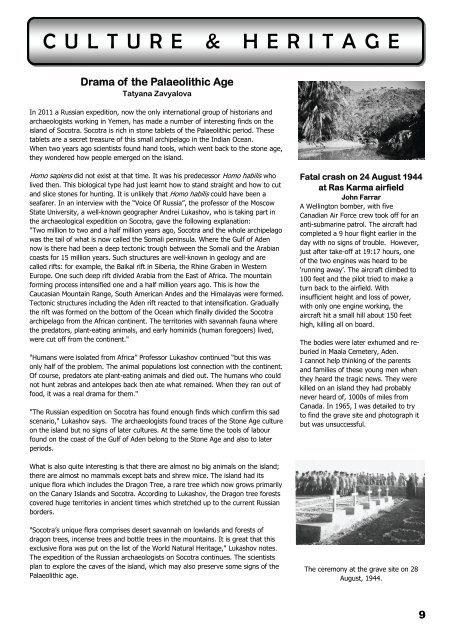TAYF the Soqotra Newsletter - Friends of Soqotra
TAYF the Soqotra Newsletter - Friends of Soqotra
TAYF the Soqotra Newsletter - Friends of Soqotra
You also want an ePaper? Increase the reach of your titles
YUMPU automatically turns print PDFs into web optimized ePapers that Google loves.
CULTURE & HERITAGE<br />
Drama <strong>of</strong> <strong>the</strong> Palaeolithic Age<br />
Tatyana Zavyalova<br />
In 2011 a Russian expedition, now <strong>the</strong> only international group <strong>of</strong> historians and<br />
archaeologists working in Yemen, has made a number <strong>of</strong> interesting finds on <strong>the</strong><br />
island <strong>of</strong> Socotra. Socotra is rich in stone tablets <strong>of</strong> <strong>the</strong> Palaeolithic period. These<br />
tablets are a secret treasure <strong>of</strong> this small archipelago in <strong>the</strong> Indian Ocean.<br />
When two years ago scientists found hand tools, which went back to <strong>the</strong> stone age,<br />
<strong>the</strong>y wondered how people emerged on <strong>the</strong> island.<br />
Homo sapiens did not exist at that time. It was his predecessor Homo habilis who<br />
lived <strong>the</strong>n. This biological type had just learnt how to stand straight and how to cut<br />
and slice stones for hunting. It is unlikely that Homo habilis could have been a<br />
seafarer. In an interview with <strong>the</strong> “Voice Of Russia”, <strong>the</strong> pr<strong>of</strong>essor <strong>of</strong> <strong>the</strong> Moscow<br />
State University, a well-known geographer Andrei Lukashov, who is taking part in<br />
<strong>the</strong> archaeological expedition on Socotra, gave <strong>the</strong> following explanation:<br />
"Two million to two and a half million years ago, Socotra and <strong>the</strong> whole archipelago<br />
was <strong>the</strong> tail <strong>of</strong> what is now called <strong>the</strong> Somali peninsula. Where <strong>the</strong> Gulf <strong>of</strong> Aden<br />
now is <strong>the</strong>re had been a deep tectonic trough between <strong>the</strong> Somali and <strong>the</strong> Arabian<br />
coasts for 15 million years. Such structures are well-known in geology and are<br />
called rifts: for example, <strong>the</strong> Baikal rift in Siberia, <strong>the</strong> Rhine Graben in Western<br />
Europe. One such deep rift divided Arabia from <strong>the</strong> East <strong>of</strong> Africa. The mountain<br />
forming process intensified one and a half million years ago. This is how <strong>the</strong><br />
Caucasian Mountain Range, South American Andes and <strong>the</strong> Himalayas were formed.<br />
Tectonic structures including <strong>the</strong> Aden rift reacted to that intensification. Gradually<br />
<strong>the</strong> rift was formed on <strong>the</strong> bottom <strong>of</strong> <strong>the</strong> Ocean which finally divided <strong>the</strong> Socotra<br />
archipelago from <strong>the</strong> African continent. The territories with savannah fauna where<br />
<strong>the</strong> predators, plant-eating animals, and early hominids (human foregoers) lived,<br />
were cut <strong>of</strong>f from <strong>the</strong> continent."<br />
"Humans were isolated from Africa” Pr<strong>of</strong>essor Lukashov continued “but this was<br />
only half <strong>of</strong> <strong>the</strong> problem. The animal populations lost connection with <strong>the</strong> continent.<br />
Of course, predators ate plant-eating animals and died out. The humans who could<br />
not hunt zebras and antelopes back <strong>the</strong>n ate what remained. When <strong>the</strong>y ran out <strong>of</strong><br />
food, it was a real drama for <strong>the</strong>m."<br />
"The Russian expedition on Socotra has found enough finds which confirm this sad<br />
scenario," Lukashov says. The archaeologists found traces <strong>of</strong> <strong>the</strong> Stone Age culture<br />
on <strong>the</strong> island but no signs <strong>of</strong> later cultures. At <strong>the</strong> same time <strong>the</strong> tools <strong>of</strong> labour<br />
found on <strong>the</strong> coast <strong>of</strong> <strong>the</strong> Gulf <strong>of</strong> Aden belong to <strong>the</strong> Stone Age and also to later<br />
periods.<br />
What is also quite interesting is that <strong>the</strong>re are almost no big animals on <strong>the</strong> island;<br />
<strong>the</strong>re are almost no mammals except bats and shrew mice. The island had its<br />
unique flora which includes <strong>the</strong> Dragon Tree, a rare tree which now grows primarily<br />
on <strong>the</strong> Canary Islands and Socotra. According to Lukashov, <strong>the</strong> Dragon tree forests<br />
covered huge territories in ancient times which stretched up to <strong>the</strong> current Russian<br />
borders.<br />
"Socotra’s unique flora comprises desert savannah on lowlands and forests <strong>of</strong><br />
dragon trees, incense trees and bottle trees in <strong>the</strong> mountains. It is great that this<br />
exclusive flora was put on <strong>the</strong> list <strong>of</strong> <strong>the</strong> World Natural Heritage," Lukashov notes.<br />
The expedition <strong>of</strong> <strong>the</strong> Russian archaeologists on Socotra continues. The scientists<br />
plan to explore <strong>the</strong> caves <strong>of</strong> <strong>the</strong> island, which may also preserve some signs <strong>of</strong> <strong>the</strong><br />
Palaeolithic age.<br />
Fatal crash on 24 August 1944<br />
at Ras Karma airfield<br />
John Farrar<br />
A Wellington bomber, with five<br />
Canadian Air Force crew took <strong>of</strong>f for an<br />
anti-submarine patrol. The aircraft had<br />
completed a 9 hour flight earlier in <strong>the</strong><br />
day with no signs <strong>of</strong> trouble. However,<br />
just after take-<strong>of</strong>f at 19:17 hours, one<br />
<strong>of</strong> <strong>the</strong> two engines was heard to be<br />
‘running away’. The aircraft climbed to<br />
100 feet and <strong>the</strong> pilot tried to make a<br />
turn back to <strong>the</strong> airfield. With<br />
insufficient height and loss <strong>of</strong> power,<br />
with only one engine working, <strong>the</strong><br />
aircraft hit a small hill about 150 feet<br />
high, killing all on board.<br />
The bodies were later exhumed and reburied<br />
in Maala Cemetery, Aden.<br />
I cannot help thinking <strong>of</strong> <strong>the</strong> parents<br />
and families <strong>of</strong> <strong>the</strong>se young men when<br />
<strong>the</strong>y heard <strong>the</strong> tragic news. They were<br />
killed on an island <strong>the</strong>y had probably<br />
never heard <strong>of</strong>, 1000s <strong>of</strong> miles from<br />
Canada. In 1965, I was detailed to try<br />
to find <strong>the</strong> grave site and photograph it<br />
but was unsuccessful.<br />
The ceremony at <strong>the</strong> grave site on 28<br />
August, 1944.<br />
9


